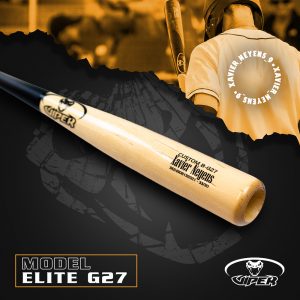With so many choices in the way of baseball bats, it may be difficult to choose the right one. Click here to see the differences in a wood vs. aluminum bat.

When it comes to baseball bats, the decision between wood and aluminum can be a tough one. To make sure you get the best bat for your needs, it’s important to know how they differ.
In this post, we’ll break down those differences and explain how to choose the best bat for your style of play.
Wood vs. aluminum bat… who wins? Keep reading to find out when we match up different properties of each.
But First… a Brief History of the Baseball Bat
In the sport’s infancy, players would make their own baseball bats. This meant that there would be a whole host of different shapes and sizes of bats. It would make the game unpredictable, and so the evolution of the baseball bat began.
Rather than one person coming up with the baseball bats we see today, a number of innovations over a number of years would eventually result in the modern-day baseball bat, although as you know, there is still a huge amount of variety.
So let’s get into the differences… and whether you should go for a wood or aluminum bat.
Weight
The difference in weight between wooden bats and aluminum is significant. Wooden bats are typically heavier than aluminum, often by as much as two or three ounces per bat. This is important for several reasons.
Bat Speed
Weight is one of the primary determinants of bat speed. If you’re looking to increase your swing speed and hit the ball harder, a heavier bat will help you achieve this goal—and vice versa.
Durability
Weight is also one of the primary determinants of durability. The larger diameter barrel on an aluminum bat allows it to be made lighter than its wooden counterpart, but this also leads to a weaker design that can break more easily when struck by a hard-hit ball.
Wood absorbs shock better than metal does; it’s not uncommon for players who use aluminum bats throughout their careers to switch back to wood at some point because they’ve suffered too many broken wrists from batted balls hitting them in the forearm (a common injury among players with metal bats).
Length of Life
Aluminum bats tend to last longer than wooden bats.
Due to their durability and resilience, aluminum baseball bats tend to last much longer than wooden ones.
The longevity of an aluminum bat can vary, depending on the brand you buy, but typically they’ll last anywhere from three years up to ten years or more if well maintained (and not used for any other purpose).
Wooden bats can begin showing signs of wear after only a few games, so it’s important that you take good care of your equipment in order for it not to break prematurely.
Feel
Wooden baseball bats offer a different feel than aluminum bats.
The more “give” of the wood makes it easier to hit a ball square on the sweet spot, resulting in better contact and fewer foul balls. Even though wooden bats are heavier than aluminum ones, they’re also less rigid, which means they have a “softer” feel.
Additionally, since it’s harder for players to get a handle on how much contact power they have when using an aluminum bat, using one can be uncomfortable for some people.
Wooden baseball bat construction varies depending on brand—some companies use hickory wood while others use ash—but all wooden bats are made from solid pieces of wood instead of being laminated together like aluminum ones.
This means that there are no seams or cracks from where two pieces join (which could cause damage if you hit beyond the sweet spot), making them more forgiving than their composite counterparts. Plus, because there aren’t any layers glued together inside these types of sticks there isn’t any risk that your favorite piece could break off during regular use (though this does happen occasionally).
The Sweet Spot
The sweet spot is the area of the bat where the ball hits with the most energy. The size of a baseball bat’s sweet spot is proportional to its diameter, mass and density.
For example, an aluminum baseball bat has a larger sweet spot than a wood one. That’s because aluminum bats have a larger cross-section area (which means they are thicker) and are less dense than wooden bats.
They also have lower swing weights, which means it takes less effort to swing them fast enough to make contact with balls traveling at high speeds toward home plate.
Bounce
Another difference between wood and aluminum bats is the give upon contact. Aluminum bats are more durable, but they also have a larger sweet spot than a wood bat.
This means that you’re more likely to strike a foul ball with an aluminum bat, because it has more give on impact and will bounce off of the ball in unpredictable directions. Wood bats don’t have this bounce-back effect; instead, they provide what’s called truer bounces, meaning they’ll fly off into one direction only.
Wooden bats are typically easier to control than their aluminum counterparts because of this true bounce trait—and because you can get them customized in any shape or size imaginable!
Wood vs. Aluminum Bat
So, what’s the result of wood vs. aluminum bat?
While there are certain advantages to each type of bat, the choice between wooden or aluminum bats is down to personal preference.
And hey, if you have a little extra cash to spend, why not get both types and see which works best for you? After all, that’s what your favorite professional baseball players do.
Why not take a look at some of our wooden bats? You’re sure to find something to fit your tastes! And while you’re on the website, check out the blog section for more helpful information and advice.






